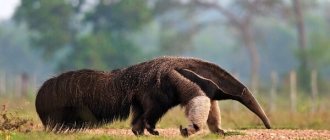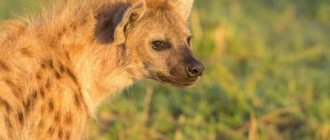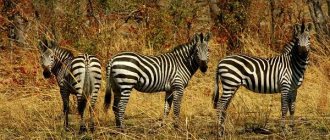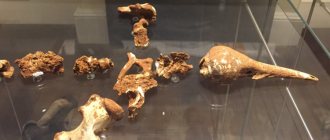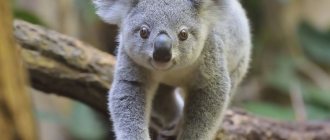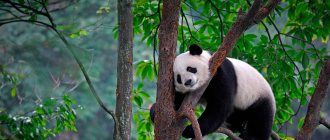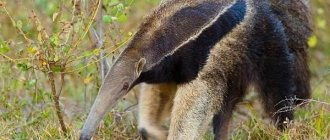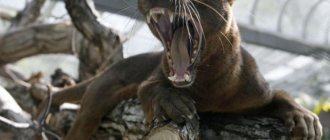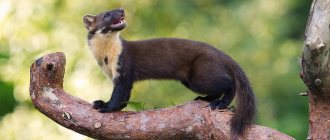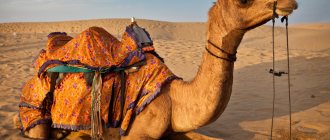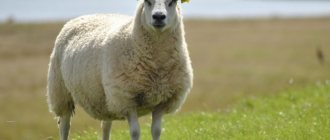The aardvark (Orycteropus afer) is perhaps the most bizarre of the African ungulates. The local population calls this representative of the fauna “aardvark”, which translated into Russian means “earth pig”. And although it does look somewhat like a pig, they are not related. This exotic animal is classified into a separate order - aardvarks (Tubulidentata).
The aardvark can rightfully be called a living fossil; it is the last surviving species of ancient ungulates. Both in appearance and internal structure it differs little from primitive early mammals. Most of his relatives died out a long time ago, and only our hero managed to survive and adapt to the changed environmental conditions.
Origin of the species and description
Photo: Aardvark
The aardvark is very similar in appearance to a pig, only it has an elongated muzzle and donkey ears, as if a wizard from a fairy tale mixed up something and created such a perky creature. The aardvark acquired its name thanks to the unusual structure of the molars, consisting of dentin tubes that are fused, have neither roots nor enamel, and their growth never stops.
The scientific name of the aardvark is translated from Greek as “burrowing limbs.” The Dutch who arrived in Africa named this animal “aard-vark”, which translates as “earth pig”. It symbolizes the aardvark's resemblance to a pig and its ability to dig holes. For a long time, the tribes inhabiting the African region called the unusual pig “Abu Delaf,” which means “father of claws,” and the aardvark’s claws are indeed powerful and remarkable.
Video: Aardvark
At first, the aardvark was classified as a member of the anteater family, apparently due to some similarities, especially in the menu. Then scientists realized that this animal had nothing in common with anteaters. Little is known about the origin of the aardvark order. It has been established that this animal is related to elephants, manatees and hyraxes.
It is clear that the aardvark is the most ancient representative of mammals. This is evidenced by the found prehistoric remains of this animal, which were discovered in Kenya. Scientists believe that these remains are more than twenty million years old. It is known that ancient aardvarks inhabited southern Europe, Madagascar and western Asia. Now they can only be found in Africa.
Aardvarks are believed to be a primitive form of ungulates. This conclusion is based not on external similarities, but on internal ones, including the structure of the brain, muscles and teeth. Zoologists suggest that this unique creature has remained virtually unchanged since ancient times and has survived to this day in its original form. The aardvark can rightfully be called a rarity, and it is also called African or Cape.
Interesting Facts
- Scientists consider the aardvark to be a living fossil because its ancient genetic makeup is very well preserved, and its genus is considered one of the most ancient among mammals of the infraclass placentals.
- Due to the special structure of the nose, the aardvark sniffs very noisily or quietly grunts. But when the animal is very frightened, it emits a fairly loud mooing cry.
- Females carry their young for about seven months. An aardvark is born weighing approximately two kilograms and half a meter long. The cub switches to basic nutrition only after 4 months. Until then, he feeds exclusively on mother's milk.
- The aardvark digs holes with amazing speed. In 5 minutes, the aardvark digs a hole one meter deep.
- This animal got its fancy name thanks to its teeth. This tooth structure is no longer found in any representative of living nature. His teeth consist of dentinal tubules fused together. They have no enamel or roots, and are in constant growth.
Appearance and features
Photo: Animal aardvark
The appearance of the aardvark is very extraordinary; it combines the features of several animals at once. The long snout of the aardvark is similar to that of an anteater. With its physique and funny snout, it resembles an ordinary pig, its large ears are similar to those of a hare or donkey, their length reaches 22 cm. The powerful tail of the aardvark is similar to the tail of a kangaroo.
The body length of the aardvark reaches one and a half meters, not counting the tail, which is more than half a meter in length. This exotic “pig” weighs about 65 kg, but there are heavier specimens – up to 90 kg. Females are slightly smaller than males. Also, the female is distinguished by the presence of four nipples.
The thick-skinned aardvark does not have a rich and beautiful fur coat. Its body is covered with sparse, rough hairs, similar to bristles, which are brownish-yellow in color. The muzzle and tail are colored white or pink, and the legs are darker in color. This animal does not need thick fur, because it lives on a hot continent. The thick and rough skin protects it from the attacks of all kinds of insects and even predators.
The strong and durable limbs of the aardvark, like powerful excavators, excel at digging the ground and destroying termite mounds. At the end of the fingers there are large claws-hooves, which serve the aardvark as a protective weapon against ill-wishers.
In general, the aardvark is quite strong, but he lacks a little courage. His sense of smell and hearing are simply excellent, this is not surprising, because his nose and ears are visible from afar. The only thing that let the aardvark down is his vision, which is very weak; his small eyes see practically nothing during the day, and at night they can only distinguish black and white shades. An interesting feature of the animal is that the aardvark is colorblind, this is how its eyes are constructed, the retina of which is equipped only with cones.
Special attention should be paid to the structure of his teeth, which has already been mentioned. The teeth are located in the back of the jaw, 4 or 6 on each half. They stand in solid columns, inside each of which there are thousands of vertical dentin tubes. Nerve endings and blood vessels pass inside the tubes. Such unusual teeth are not covered with enamel and they do not have roots, but their growth is constant, because they wear out quickly.
Behavior
The natural habitat of this species is endless grassy savannas, thickets of bushes and forest edges with sparse dead wood. Aardvarks carefully avoid dense tropical jungles and rain forests.
These mammals prefer to live in splendid solitude, sleeping during the day in their burrow and leaving in search of prey only at dusk. They have quite extensive home ranges. The areas of males are much larger than those of females and reach 5 square meters. km.
Each animal has several burrows and, outside the mating season, almost constantly moves from one burrow to another. Burrows are different. In most cases, these are simply holes of varying depths, used for short rest and shelter in case of danger.
Permanent housing is built conscientiously. It consists of a spacious bedroom measuring 2x3 m with several corridors, sometimes reaching a length of 13 m.
In search of food, the Cape aardvark moves in small steps, carefully sniffing a strip of land about 30 m wide. Its sense of smell is excellent. Smelling insects, he instantly tears up the ground with strong claws of his front paws and sticks his tongue into the ant's nest. The tongue is long and sticky, insects easily stick to it. The peculiarly arranged teeth crush the chitinous cover of the ants, and the swallowed victims are ground in the muscular stomach.
In addition to ants, aardvarks happily eat termites, breaking the walls of their termite mounds without much difficulty. In the absence of such delicacies, they subsist on grasshoppers, crickets and beetles. The diet also includes some local wild vegetables.
Possessing thick skin and strong limbs, in the event of a surprise attack, aardvarks lie on their backs and inflict painful injuries on the offender with their sharp claws. Only hyenas dare to attack them. Cubs and older animals can be preyed on by lions, cheetahs, wild dogs and pythons. Aardvarks do not like to test their fate and, instead of fighting with enemies, prefer to hide in a hole at the slightest danger.
Where does the aardvark live?
Photo: Aardvark Africa
Although the ancestors of the aardvarks were distributed across different continents, now this one and only representative of the aardvark order has a permanent place of residence only within the sultry African continent. These amazing creatures settled south of the Sahara, with the exception of the jungle located in Central Africa. It is known that populations that previously lived in the Nile Valley and in the highlands of Algeria have completely died out.
Aardvarks prefer drier climates, so they avoid large forest areas located on the African equator, because... It often rains there. These animals do not like swampy and too rocky places, because it is difficult to dig holes on such soils. In the mountain ranges, you will not find an aardvark higher than 2 km in height. These unusual animals love African savannas, where it is convenient to dig huge tunnels in which aardvarks prefer to sleep during the day, leading a rather secretive and mysterious life, about which scientists still know little.
What does an aardvark eat?
Photo: Animal aardvark
To get a thorough meal, the aardvark chooses the night time, when it feels most safe, and don’t forget that during the day it is practically blind. This animal's menu is as exotic as itself; its main dishes are ants and termites. The aardvark also does not disdain various larvae of other insects, eats locusts, and also contains other orthoptera in its diet. Rarely, but still, mushrooms and a variety of juicy fruits and berries may be present on the aardvark’s menu.
On average, a mature aardvark consumes about 50,000 different insects per day. The tongue of this animal is very similar to the tongue of the anteater, therefore their diet is identical. The length of this organ is very impressive. If we take into account the length of the aardvark’s muzzle, then its tongue is even longer, because it can protrude 25 cm from its mouth. The unusually long tongue has great mobility and is covered with viscous saliva, which, like glue, attracts all kinds of insects, sometimes even the most microscopic ones.
An interesting fact is that aardvarks living in captivity have a more varied menu. They do not give up meat, milk, eggs, and love various cereals. People enrich their food with specialized vitamin supplements.
These funny mammals have a special talent associated with taste preferences. Aardvarks are the only distributors of cucumber seeds from plants that belong to the pumpkin family and ripen deep underground. Animals, like experienced diggers, pull them out of the depths and eat them with pleasure, thereby allowing the plant to spread to other territories. It’s not for nothing that the aardvark is nicknamed the “earthen pig.”
Features of character and life activity
Photo: Aardvark
The aardvark is a very secretive and mysterious creature; little is known about its life activity, because... it has not been sufficiently studied. He is alert and active at dusk, and during the day he prefers to hide in a hole, where he sleeps sweetly, having worn himself out during the night. Sometimes the aardvark allows himself to enjoy sunbathing; he does this at dawn and not far from his shelter.
The Aardvark is a tireless and skilled digger, capable of digging through huge underground corridors. In this he is helped by powerful front paws with two pairs of fingers, on which there are strong claws-hooves, raking the earth no worse than a shovel. The hind limbs and tail throw away the already loosened soil.
The shelter for the aardvark is not just one tunnel, but a whole dug labyrinth, the corridors of which can reach up to twenty meters in length. Sensing a threat, the animal can hide in one of the many branches of its shelter. Such a house also saves from the scorching African sun; in the aardvark’s hole the climate is always comfortable, the temperature does not rise above 24 degrees plus.
Abandoned aardvark burrows make wonderful havens for animals such as:
- warthog;
- mongoose;
- jackal;
- porcupine.
At night, the aardvark often travels more than twenty kilometers, going in search of food in the form of termites and ants. Sensitive hearing and smell help him a lot with this. And the most powerful claws and hooves can easily destroy any anthills and termite mounds.
Speaking about the character and disposition of the aardvark, it can be noted that he is very modest, meek and a little cowardly. The animal carefully listens to its surroundings all the time. Any suspicious sound causes the aardvark to seek shelter in a hole or burrow into the ground if there is no other shelter nearby. This exotic animal is very slow and clumsy.
Scientists suggest that each individual occupies a certain territory, the size of which is from two to five square kilometers, and the aardvarks prefer to stick to it. It is impossible not to mention one more skill of the “earth pig” - it can swim perfectly, although it lives mainly in arid areas.
Nutrition
The diet of mammals is based on termites, ants, beetle larvae, and locusts. Sometimes aardvarks feed on mushrooms, fruits, and berries. Animals walk along previously explored routes, sniffing the ground in search of food in the hope of finding food. They are capable of eating about 50,000 termites per night. The skin of mammals is so thick that insects cannot bite through it.
Social structure and reproduction
Photo: Baby aardvark
Aardvarks have been little studied, but it is believed that these animals prefer an isolated, solitary existence; they do not form strong family unions. Zoologists also did not notice a special mating season; when observing aardvarks, mating occurred at different periods of the year. Individuals living in captivity usually give birth to their young in February, March or June. In nature, this depends on the habitat of the animal.
The female's pregnancy lasts about seven months. Almost always, a mother gives birth to one single baby; it is extremely rare that twins are born. The babies are a little more than half a meter long and weigh about two kilograms. They have no hair at all, and their skin is pinkish in color. The long-nosed mother feeds her offspring with milk until the age of four months. Even at this time, the female feeds the cub with ants, accustoming him to this food almost from birth. Upon reaching four months of age, a caring mother begins to teach her child to get food so that he becomes independent.
Interestingly, the cubs begin to crawl out of the hole at the age of two weeks. And when they are six months old, they begin intensive training in digging holes, although they still live in their mother’s shelter.
Only at the age of one year do young animals become outwardly identical to adult individuals, and aardvarks reach sexual maturity by the age of two years. In wild, difficult natural conditions, aardvarks live up to 18 years, and in captivity they can live up to 25.
Offspring
Females carry their young for seven months, usually one aardvark is born, very rarely two. Two weeks after birth, the babies begin to leave their holes for short walks, accompanied by their mothers, who will feed them for a little over a year.
Mature aardvarks begin to act independently by the beginning of the next mating season of adults, that is, after approximately one year. Under natural conditions they can live up to 17-20 years.
Natural enemies of aardvarks
Photo: Animal aardvark from Africa
The aardvark has many enemies, because it is quite a tasty prey for large predators. The animal does not have a fierce and courageous disposition, so it is constantly on the alert, catching any insignificant rustle. The aardvark is always ready to scurry into its hole or burrow into the ground to escape a threat.
The main natural enemies of the “ground pig” include:
- Lviv;
- spotted hyenas;
- cheetahs;
- hyena dogs.
If a collision cannot be avoided, then the aardvark goes on the defensive, defending itself with its powerful forelimbs or a strong tail. It’s good that these modest creatures have quite large dimensions and thick skin, so small predators cannot approach them. Baby aardvarks can be eaten by a python.
An interesting fact is that, when experiencing severe fright, the aardvark begins to moo loudly and specifically, although usually he only sniffles and grunts slightly.
One of the most dangerous enemies of the aardvark is man, who exterminates these peaceful animals for their pork-like meat, skin and teeth, which are used to make various accessories and decorations. The number of these ancient animals at this point in time is not precisely determined, but tends to decrease, so people should think about their, sometimes selfish, interests.
Animal hunting
Aardvarks have already been exterminated across large areas of Africa, and their numbers are constantly decreasing: the animals are constantly hunted, killing unusual mammals for meat, which, according to local residents, tastes like pork. Thick animal skin is used to make jewelry, belts, and saddles.
This is interesting: Water deer - basic facts and photos
